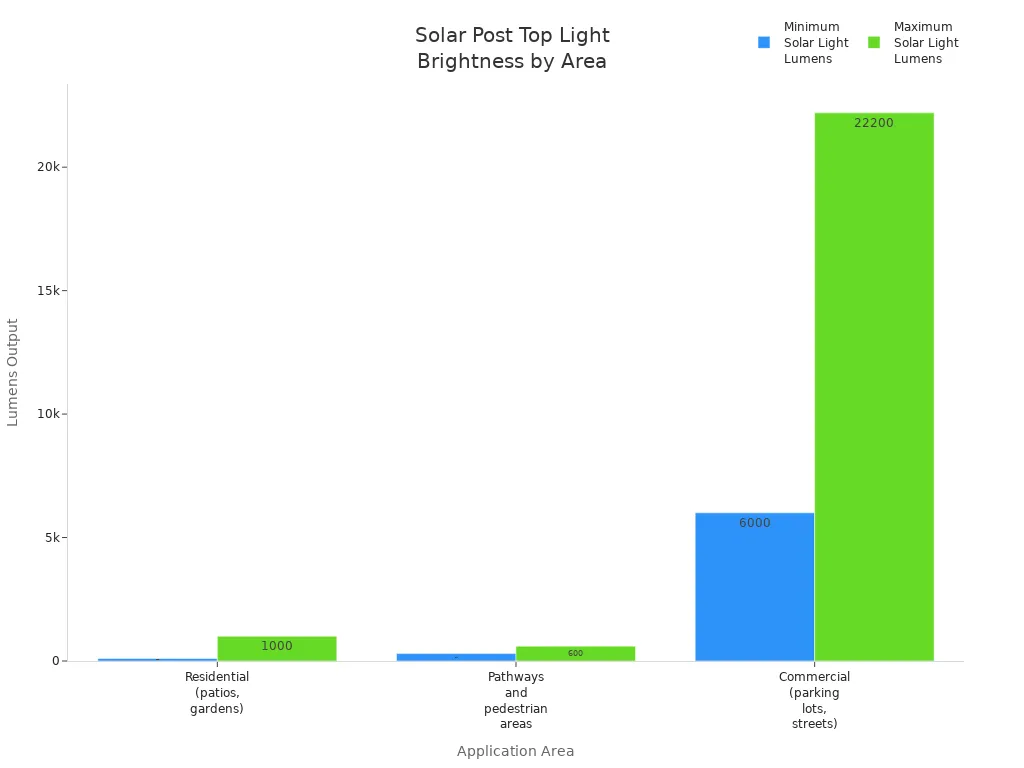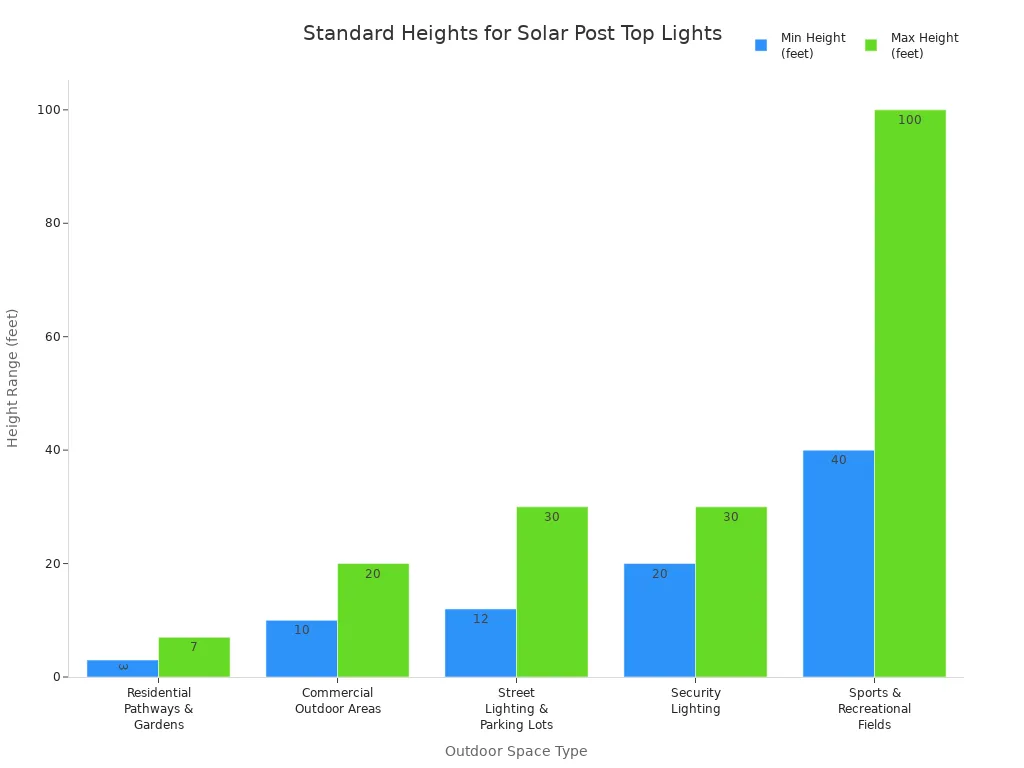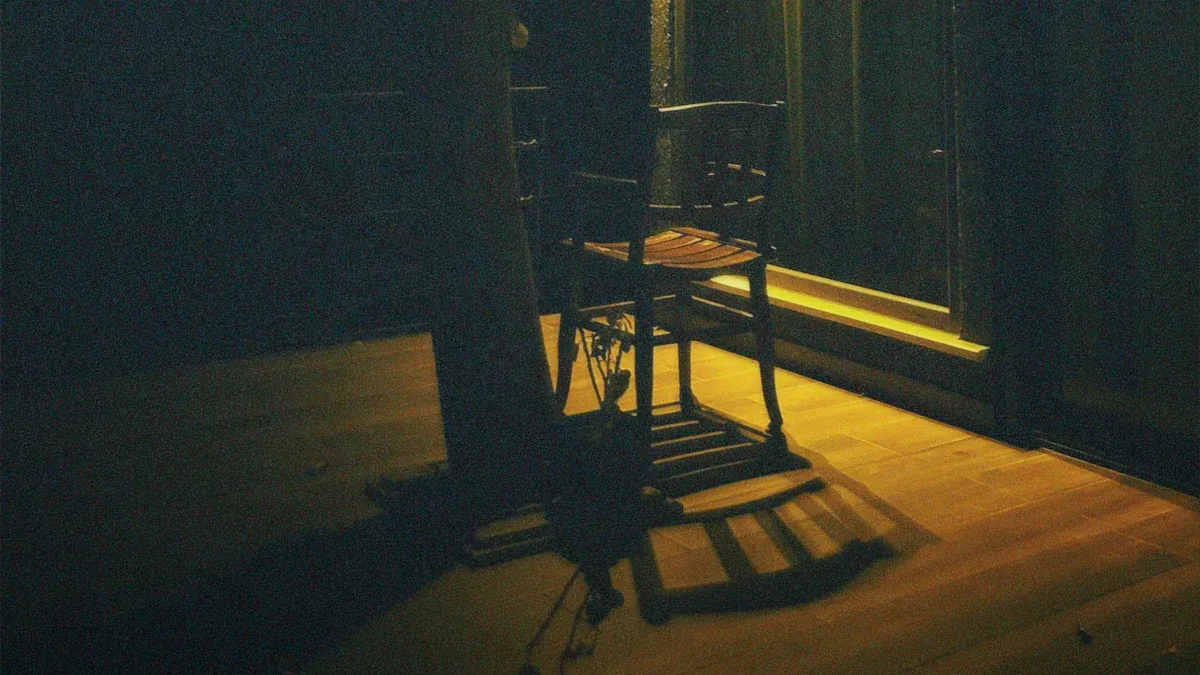Views: 0 Author: @Rice Solar Lighting Publish Time: 2025-07-31 Origin: www.ricesolar.com
When you choose solar light for your yard, you want it to work well and last. Start by checking how much sunlight your spot gets, then pick the right brightness for your needs. Make sure the battery and solar panel are good quality. Many people make mistakes like picking the wrong brightness, using weak batteries, or placing a solar post top light in the shade. Watch out for these issues:
Picking a light that is too dim for walkways or too bright for decoration
Using batteries that do not last long
Placing lights where they cannot get enough sun
Setting the light at the wrong height
If you match the features to your weather, space, and what you want to light up, you will get the best results.
Pick solar post top lights that fit your area and needs. Check how bright they are, how good the battery is, and how much sun they get. - Find lights with strong batteries, at least 500 mAh. Make sure the solar panels can charge even when it is cloudy. This helps the lights stay on all night. - Choose the right brightness and color temperature. This helps set the mood and keeps your outdoor space safe. - Put the lights where they get 6 to 8 hours of sun. Keep the solar panels clean. Place the lights at the best height for good lighting. - Take care of your lights by cleaning the panels often. Change the batteries if the lights get dim or stop working. This will help them stay bright.
Image Source: unsplash
Solar post top lights use the sun’s energy to light up your outdoor spaces. You do not need to run wires or plug them in. These lights work on their own, turning on at dusk and off at dawn. Here’s how the main parts work together:
Solar Panel: This sits on top and soaks up sunlight during the day. It changes sunlight into electricity.
Battery: The battery stores the electricity made by the solar panel. It keeps the power ready for nighttime.
Energy Management System (Controller): This smart part controls how much power goes from the panel to the battery and from the battery to the light. It helps the battery last longer and keeps everything running smoothly.
LED Fixture: The LED bulbs use the stored energy to shine bright light at night. LEDs use less power but give off a lot of light.
Pole: The pole holds up the whole light and keeps it steady.
Extra Parts: Some lights have sensors that turn them on when it gets dark or off when the sun comes up. You might also see mounting hardware and wires inside.
Tip: Solar post top lights run all night without you having to do anything. Just make sure they get enough sun during the day!
You can use solar post top lights in many places. They work great for both homes and businesses. Here’s a quick look at where people use them most:
Popular Applications | |
|---|---|
Commercial | Parks, Pathways, Campuses, Business Parks, Office Complexes, Downtown Streets, Government Facilities, Hotels, Parking Lots, Retail Centers, Schools, Sidewalks |
Residential | Neighborhood Entrances, HOA Areas, Courtyards, Gardens |
These lights do more than just look nice. They help people see better at night and make outdoor areas safer. You often see them in parks, along walkways, or at the entrance to a neighborhood. Since they do not need wires, you can put them almost anywhere the sun shines.
When you choose solar light for your outdoor space, you want to get the best fit for your needs. Let’s break down the most important things to look for so you can make a smart choice.
Brightness is one of the first things you’ll notice about any solar post top light. You measure brightness in lumens. The right amount depends on where you plan to use the light.
For walkways and driveways, look for lights in the 100-400 lumen range. This gives you enough light to see safely without being too harsh.
If you want a soft, decorative glow for your garden or patio, 50-100 lumens works well.
For security or larger areas, you might need 300-600 lumens or more.
Here’s a quick guide:
50-100 lumens: Best for decoration or gentle path lighting.
100-300 lumens: Good for walkways, driveways, and general outdoor lighting.
300-600 lumens: Use for bigger driveways or when you want extra security.
600+ lumens: Usually for commercial spaces or parking lots.
Tip: Solar post top lights for homes usually range from 100 to 1,000 lumens. This matches the brightness of most household outdoor lights.
You can see how solar lights compare to traditional electric lights in the table below:
Application Area | Solar Post Top Light Lumens Range | Comparison to Traditional Electric Lights |
|---|---|---|
Residential (patios, gardens) | 100 to 1,000 lumens | Comparable to typical household lighting |
Pathways and pedestrian areas | 300 to 600 lumens | Suitable for moderate illumination |
Commercial (parking lots, streets) | 6,000 to 22,200 lumens | Matches or exceeds high-performance traditional lighting |

The battery and solar panel are the heart of your solar post top light. A good battery keeps your light shining all night. Most high-quality lights use rechargeable batteries with a capacity around 500 mAh, which gives you about 5-6 hours of light after a full charge.
Look for these features:
A battery with at least 500 mAh capacity.
A solar panel that charges well even on cloudy days.
Easy-to-replace batteries for longer life.
If you want your light to last from dusk till dawn, make sure the battery and panel can handle it. When you choose solar light, always check these specs.
Color temperature changes the mood of your outdoor space. You measure it in Kelvin (K). Here’s what you need to know:
Color Temperature Range | Kelvin (K) Range | Effect on Outdoor Ambiance and Typical Use Cases |
|---|---|---|
Warm White | Cozy, inviting glow for patios and gardens | |
Neutral White | 4000K–5000K | Bright, clear light for security and visibility |
Cool White | 6000K–6500K | Daylight-like brightness for streets and parks |
Some solar post top lights let you adjust the color temperature. This helps you match the light to your mood or event.
Outdoor lights face rain, dust, and sometimes snow. You want your solar post top light to last through all seasons. Look for an IP65 rating or higher. This means the light is safe from dust and can handle strong water jets, like heavy rain.
If you live in a place with harsh weather, consider IP66 or IP67 for extra protection. Lower ratings like IP44 are not enough for fully exposed spots.
Note: IP65 is the standard for most outdoor solar lights. It keeps your light working even in tough weather.
The material of your solar post top light affects how long it lasts. Here’s a quick look at common materials:
Material | Properties & Impact on Longevity | Usage & Considerations |
|---|---|---|
Aluminum | Lightweight, rust-resistant, good at cooling | Great for commercial or heavy-duty use; very durable |
Plastic | Budget-friendly; quality varies; low-end types may fade or crack | Good for saving money, but not as tough |
Stainless Steel | Strong, resists rust, looks sleek; heavier and costs more | Best for long-term use; highly durable |
If you want your light to last for years, go for aluminum or stainless steel. Plastic works if you want to save money, but it may not last as long.
The height of your solar post top light changes how it lights up your space. Here’s a guide to help you choose:
Outdoor Space Type | Standard Height Range (feet) | Purpose / Notes |
|---|---|---|
Residential Pathways & Gardens | 3 to 7 | Gives soft, downward light for homes and gardens. |
Commercial Outdoor Areas | 10 to 20 | Balances light and ambiance for bigger spaces. |
Street Lighting & Parking Lots | 12 to 30 | Lights up wide areas for safety. |
Security Lighting | 20 to 30 | Covers large areas for security. |
Sports & Recreational Fields | 40 to 100+ | Used for big fields, keeps shadows away. |

Pick a height that matches your space. Shorter lights work well for gardens and paths. Taller poles are better for parking lots or security.
Tip: When you choose solar light, think about the style too. Some lights look modern, others look classic. Match the design to your home or garden for the best look.
Smart controls make your solar post top light more efficient. Many lights have dusk-to-dawn sensors that turn on at night and off in the morning. Some models have motion sensors that only turn on when someone walks by. This saves battery and adds security.
Other handy features include:
Timers that let you set how long the light stays on.
Dimming options to lower brightness when you don’t need full power.
Manual switches for more control.
These features help you save energy and make your light last longer.
When you choose solar light, balance cost and quality. Cheaper lights may save you money at first, but they might not last as long or shine as bright. Look for trusted brands like Harbor Breeze and Deckorators. These brands get good reviews for durability and weather resistance.
Here are some tips to get the best value:
Pick the right brightness for your needs. Don’t pay extra for more lumens if you only want decoration.
Make sure the light has a good battery and solar panel.
Check for a solid warranty and good customer reviews.
Note: Place your solar post top light where it gets plenty of sun. Clean the solar panel often and replace the battery when needed. This keeps your light shining bright for years.
When you choose solar light, always match the features to your space. For security, pick higher lumens and motion sensors. For decoration, go with lower lumens and warm color temperatures. This way, you get the right light for every job.

Image Source: pexels
Getting the most out of your solar post top light starts with picking the right spot. You want your light to soak up as much sun as possible. Here’s how you can make sure your light charges well every day:
Choose a location that gets direct sunlight for at least 6-8 hours. This helps the battery charge fully.
Keep your light away from shade. Trees, buildings, or even fences can block the sun and lower the light’s power.
Adjust the solar panel angle. In winter, tilt the panel more to catch the lower sun. In summer, make it flatter.
Face the solar panel south if you live in the Northern Hemisphere. This gives you the best sunlight.
After you install the light, check it at different times of day. Make sure nothing blocks the sun.
Tip: Clean the solar panel often. Dust and leaves can block sunlight and make your light dimmer.
Before you install your solar post top light, check if it fits your post. Most lights use a 2 3/8-inch tenon mount. This size works for many standard poles. Some lights come with adapters or slip fitters for different pole sizes. Always match the mounting bracket to your pole’s size and tighten the bolts well. This keeps your light steady, even on windy days.
Many solar post top lights use E26 or E27 bulb sockets. Check the socket type before you buy.
Make sure the lamp post is weatherproof. This protects your light from rain and moisture.
Installing your solar post top light is simple if you follow a few steps:
Mount the light using strong hardware. Tighten all screws and bolts.
Use a level to keep the solar panel flat or at the right angle.
Place the light away from other bright lights. Too much light nearby can confuse the sensor.
Check the stability after storms or strong winds.
Follow the instructions from the manufacturer for the best results.
Common Challenge | What Happens | How to Fix It |
|---|---|---|
Light does not charge or shine well | Move to a sunnier spot | |
Dirty solar panel | Less charging power | Wipe with a damp cloth |
Loose mounting | Light wobbles or falls | Tighten bolts and screws |
Battery wears out | Light gets dim or stops working | Replace the battery |
Note: Always follow local rules for outdoor lighting. This keeps your lights safe and helps the environment.
Keeping your solar post top lights clean helps them shine bright and last longer. Dirt, pollen, and leaves can block sunlight from reaching the panel. You should check your lights every few months for grime or debris. Here’s how you can clean them safely:
Use a soft brush or sponge with mild soap and water. Avoid harsh chemicals or rough scrubbers.
Gently wipe the solar panel and the light fixture.
Rinse with clean water to remove any soap.
Clean in the early morning or late afternoon when the panels are cool.
Trim plants or branches that might shade your lights.
Tip: Clean your solar panels at least twice a year, or more often if you live in a dusty or wooded area. Rain helps a little, but it won’t remove heavy dirt.
Batteries power your solar lights at night. Most last between 5 and 15 years, but weather and use can change this. You might notice your light getting dim, not staying on as long, or not working at all. These are signs the battery needs replacing. Other signs include swelling, leaks, or corrosion on the battery case.
When you replace the battery, choose one with the right size and capacity. Always check for damage and wear gloves for safety. If your battery is older than the warranty period, it’s a good idea to swap it out before it fails.
Sometimes your solar post top light might not work as expected. Here are some common problems and what you can do:
Light won’t turn on: Check if the panel is clean and getting enough sun. Replace the battery if needed.
Light is dim: Clean the panel and check for shade. Make sure the battery holds a charge.
Sensor issues: Wipe the sensor clean and move the light away from other bright lights.
Water inside the light: Dry the inside and seal any cracks. Make sure your light has a good weatherproof rating.
Loose or broken parts: Tighten screws and check wires for damage.
Note: If you try these steps and your light still doesn’t work, you may need to reset the device or call a professional for help.
When you choose solar light for your posts, focus on what matters most for your space and climate. Use this checklist to guide your decision:
Check supplier experience and product quality.
Review technical specs and weather resistance.
Look for design options and after-sales support.
Confirm logistics and installation help.
Solar post top lights save money and help the planet. See how they compare:
Aspect | Solar Post Top Lights | Traditional Outdoor Lights |
|---|---|---|
$0 | $200–$400 | |
Carbon Footprint | Zero CO2 | 1–2 tons CO2/year |
You get reliable, eco-friendly lighting that lasts for years.
Most solar post top lights shine for 6 to 10 hours after a full day of sun. You get the best results when the battery is new and the panel gets plenty of sunlight.
Yes, you can use them in winter. Just make sure the solar panel stays clear of snow and dirt. The lights may run shorter on cloudy days, but they still work.
No, you do not need to turn them on or off. Most models have sensors that switch the lights on at dusk and off at dawn. You just set them up and let them work.
